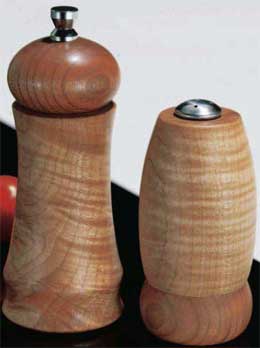
Q: I am planning to make a salt box and pepper mill from a jobillo wood blank. My question is, after hollowing out the insides of each, should they be finished/sealed with poly, shellac, a food grade oil or anything at all. I’m not sure if the oils from the wood are A. harmful or B. will react negatively with either the salt or peppercorns and create an odd flavor.- Dick A.
Tim Inman: Astronium graveolens is the “other” name for jobillo. It is an oily Central American wood. I would seal the inside, if it were my project, for two reasons: stability and toxicity. Sealing will help stabilize the wood and prevent it from distorting. You can’t stop moisture exchange, but you can slow it down. Salt is obviously going to dry the wood, but pepper will also draw moisture. So, sealing is good.
Toxicity is another issue, although probably a minor one. A little quick search confirmed my suspicion. Jobillo is in a nut tree family with cashews. Cashews, Anacardium occidentale, protect themselves and their seed pods with anacardic acid, which is related to urushiol. Urushiol is in the sap material traditionally employed in oriental lacquering. Where else might one find urushiol? Poison ivy. The risk of sensitization is certainly more to the maker (you) than to the user of the salt of pepper. The risk is also very small. Some people (like me!) are very sensitive to poison ivy, though, and just a little exposure can be a problem. (Could this have anything to do with my working exotic furniture woods for decades?!) Many of our favorite hardwoods have natural defense oils and other mechanisms built into them by Mother Nature. We use these woods all the time, and they make beautiful things. No need to panic, but knowing our materials always helps us make better choices in selecting and using them. My advice: don’t breathe the dust, and wash your hands with soap and water immediately after working these woods.
Chris Marshall: Woodworker’s Source has a handy Wood Library search feature that can help you learn more about new and different woods you may want to try. It lists both domestic and exotic species and provides lots of useful information including a description of the tree and lumber, a photo of the wood, its working properties, durability, weathering and strength. In some instances, you can also learn about toxicity concerns and suitable substitutes. In the case of jobillo, no toxicity information is given, but the wood is reported to have no distinctive odor or taste. The search feature is free and, I think, worth bookmarking for quick reference.







